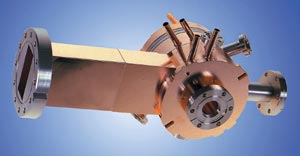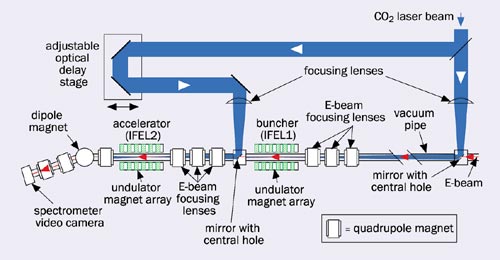Ilan Ben-Zvi describes Brookhaven’s facility for long-term R&D in advanced accelerator physics, which he directed until recently.
The Accelerator Test Facility (ATF) at the Brookhaven National Laboratory is the first advanced accelerator facility designed and built to serve the community active in advanced accelerator research. A proposal-driven user facility, it is dedicated to long-term R&D in the physics of particle and laser beams. The users, who come from universities, national laboratories and industry, carry out R&D on advanced accelerator physics, studying in particular the interactions of high-power electromagnetic radiation and high-brightness electron beams, including laser acceleration of electrons and free-electron lasers (FELs). Other topics include the development of electron beams with extremely high brightness, photoinjectors, electron beam and radiation diagnostics, and computer controls.
The core of the ATF consists of a high-brightness photoinjector electron gun, a 75 MeV linac, high-power lasers synchronized to the electron beam to a picosecond level, four beam lines (most equipped with energy spectrometers) and a sophisticated computer-control system. The facility, which has been in operation since 1992, provides the best high-brightness electron beams up to an energy of 75 MeV, with, for example, a normalized rms emittance of 0.8 µm at a charge of 0.5 nC. The bunch length is variable from 1 to 8 ps, with a bunch compressor to extend the range down to 100 fs.

The users enjoy an extensive support infrastructure, which has a few tens of million dollars of investment and is embedded in a large and highly capable national laboratory. ATF staff provide the users with close support and expertise in electron beam-dynamics, lasers and optics, advanced diagnostics, energy spectrometers and computer control. This support is free of charge, while the use of other resources at Brookhaven, as well as the dedicated equipment for experiments, are the responsibility of the users. The users’ activities are reviewed by the ATF Programme Advisory Committee, which includes members from various universities and national laboratories. The committee keeps the number of users relatively steady.
The publication rate from experiments at the ATF is high, with an average of more than three papers in Physical Review per year. The facility is also an excellent training ground for graduate students in accelerator physics and the physics of beams, with on average more than two graduations a year. While a large number of students come from nearby Stony Brook University, the majority come from universities across the US and throughout the rest of the world. The ATF staff is proud of its contribution to graduate education in accelerator and beam physics, through education and support of the students.
The ATF receives steady support from the US Department of Energy, which has enabled the facility to evolve not only in terms of hardware and staff expertise but also in terms of stability and the superb performance of the electron and laser beams. This environment is beneficial to the difficult, cutting-edge experiments in advanced accelerator and coherent source physics that are carried out by the users.
From photocathodes to plasma wake fields

The work of the ATF has pioneered metallic photocathodes such as copper, magnesium and, most recently, niobium, for robust, good quantum efficiency operation. These photocathodes are now found everywhere in the world and are also produced industrially. The same holds true for the radiofrequency (RF) guns, with the celebrated Brookhaven one-and-a-half-cell S-band series of guns. The series now stands at Gun IV (see figure 1), while a new superconducting continuous-wave RF gun is being developed. Examples of advanced diagnostics undertaken at the ATF include the first slice-emittance measurement, the first pulse-length measurement using shot-noise driven fluctuation in incoherent radiation, high-resolution phase-space tomography and more. The ATF is also developing high-performance plasma capillary channels that channel the carbon-dioxide laser beam and provide a convenient source of plasma for a variety of experiments. Most recently, R&D is being carried out on optical stochastic cooling of hadron beams.
By far the most important aspect of the ATF is the research carried out by its users. Milestone experiments in laser acceleration include the work on inverse Cherenkov acceleration and the inverse free-electron laser (IFEL). STELLA, the Staged Electron Laser Acceleration experiment, has successfully used two laser accelerators (both IFELs), demonstrating the steady production of 3 fs electron-beam bunches (figure 2). With this configuration STELLA II has shown monoenergetic laser acceleration for the first time.

Experiments on the development of laser-photocathode RF guns include the “Next Generation Photoinjector”, or Gun III in the ATF series. Others concern the generation of unique radiation sources, including the pioneering high-gain harmonic-generation FEL that set a new trend towards coherent, ultrashort pulse X-ray FELs. The VISA experiment at the ATF, which served as a proof-of-principle experiment for the Linac Coherent Light Source project at SLAC, reached saturation at visible wavelengths and demonstrated the generation of harmonics, their growth and saturation properties and the relationship to microbunching. The Compton scattering experiment to investigate Compton scattering between energetic electrons and laser beams produces a record of about 108 hard X-ray photons per pulse of a few ps.
Most recently, a plasma wake-field experiment demonstrated the phase relationship between the accelerating and focusing component of the plasma wake. This showed a 90° phase difference, thus allowing plasma wake accelerators to accelerate and focus the beam at the same phase.





